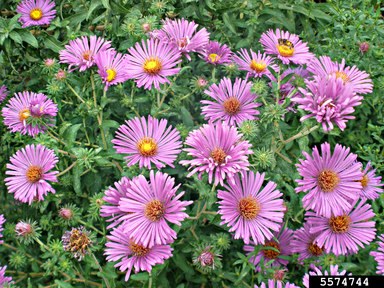Posted: September 8, 2021
One of the most colorful flowers of fall is also September’s birth flower. It is the aster, sometimes referred to as the starwort or frost flower. Belonging to the daisy family, aster is a perennial with over 600 species. Formerly wildflowers, asters are seen in many colors ranging from white to orange but commonly have pink, white, red, mauve, or lilac blooms. In northeast Pennsylvania, our best-known aster displays a striking bluish-purple color.

photo by Ansel Oommen, Bugwood.org
The floriography, or language of flowers for the aster begins with the ancient Greeks. "Aster" in Greek means "star" and is a reference to the plant's star-shaped flowers. According to folklore, the Greek goddess Astraea was saddened by how few stars appeared in the night sky. She was so distraught that she began to cry. As tears streamed down her face and hit the ground, they grew into beautiful star-shaped aster flowers. The ancient Greeks used asters to create wreaths which they placed on altars to pay tribute to the gods.
Asters are symbols of all-powerful love, affection, and wisdom. They have also been known to represent valor, purity, innocence, royalty, and faith. Possibly because of such powerful symbolism, they were once burned to ward off serpents.
Different aster colors can also convey different meanings:
- Purple asters represent wisdom and royalty. Within European civilizations, members of royal families wore purple to signify their nobility.
- White asters symbolize purity, innocence, and new beginnings.
- Red and pink asters mean undying devotion.
It is estimated that there are over 600 distinct species of these flowers. Like the daisy, asters can be found in North America, Europe, Asia, and South America.
The most common asters in North America are the New England aster (Symphyotrichum novae-angliae) and the New York aster (Symphyotrichum novi-belgii). The New York type tends to be shorter (standing at 1 foot) than the New England type (3 feet or more). Both are native to North America and provide excellent sources of late-season pollen for bees and other pollinators. Planting a native species of aster can give vital support to our pollinators. There are many hybrid and non-native species available for sale. Be sure to confirm the species name if you are looking for a native aster.
Despite its appearance, the aster flower is not one large single flower, but a collection of many tiny tubular flowers. The seeds of some varieties look like miniature parachutes, which are carried and spread by the wind. They are a favorite flower of butterflies. Monarch butterflies use them as resting stops during their annual migrations because the aster's flowering season coincides with the peak of their migration.
Asters prefer climates with cool, moist summers and cool evening temperatures. Their USDA (United States Department of Agriculture) Hardiness Zones are 3-8, which includes Pennsylvania. Choose a site with full to partial sun. Soil should be moist and loamy with good drainage. Mix in compost prior to planting. Plant 1 to 3 feet apart depending on their anticipated mature size. Light fertilizer applied early in the season can benefit the plantings. Some tall New England asters may need staking.
Asters can be grown from seed, but germination may be uneven. Start seeds indoors during the winter in pots or flats, keeping them refrigerated for four to six weeks (about one and a half months) to simulate winter dormancy. They need this period of cold to begin germination. Plant young plants outside after the danger of frost has passed in the mid-to-late spring.
Fully-grown, potted asters may be planted whenever they become available in your area. Give plants plenty of water at the time of planting. Add mulch to keep soil cool and prevent weeds. A thin layer of compost or balanced fertilizer with a 2-inch layer of mulch added around the plants every spring will encourage vigorous growth.
Water plants regularly during the summer. However, many asters are moisture sensitive; if your plants have too much or too little moisture, they will often lose their lower foliage or not flower well. Watch for stressed plants and try a different watering method if your plants are losing flowers.
Asters range in bloom time from early September to late October, with a particular species or cultivar usually blooming for two or three weeks.
Asters are sensitive to powdery mildew, rusts, white smut, leaf spots, stem cankers, aphids, mites, slugs, snails, and nematodes. The main plant disease is powdery whitish growth that may appear on leaves from late June or July onwards, New York varieties are more susceptible to powdery mildew.
This plant is versatile and can be used in borders, rock gardens, wildflower gardens, and other landscapes. Depending on the variety, the plant's height can range from 8 inches to 8 feet, so there are asters suitable for every garden.
Pinch back asters a few times in the early summer to promote bushier growth and more blooms. Aster flowers that mature fully may reseed themselves but resulting flowers may not bloom true. This means that you may not get the same color flowers that you originally planted.
Divide every two to three years in the spring to maintain your plant's vigor and flower quality.
Asters add color to the late summer and early fall garden when many summer blooms may be fading. They also complement the rich colors of fall mums. Asters work well as cut flowers and make attractive fall arrangements, wreaths, or fall wedding decorations. Do not forget bouquets of asters for September birthdays! Cut asters back in winter after the foliage has died or leave them through the winter to add some off-season interest to your garden.
Flower enthusiasts do not have to despair after summer blooms are gone. With late-blooming plants like the aster, look forward to vibrant colorful plants that also provide food for our hardworking pollinators that will revisit us when winter has passed!
~ by Joan Banyas, Penn State Master Gardener of Luzerne County

